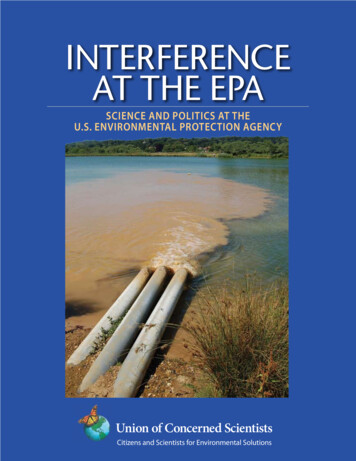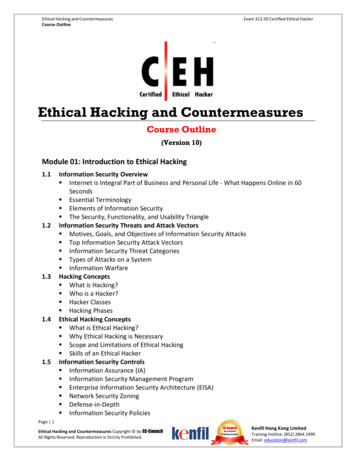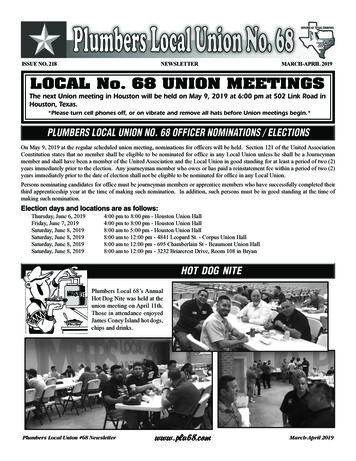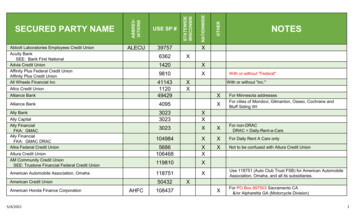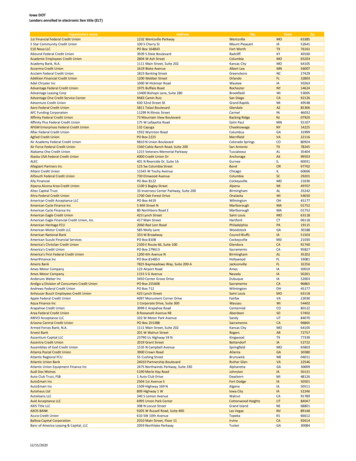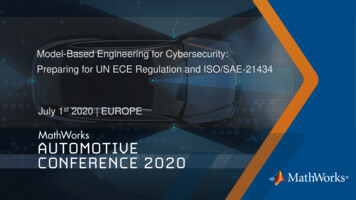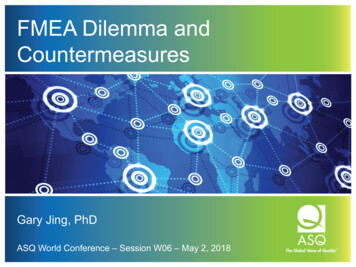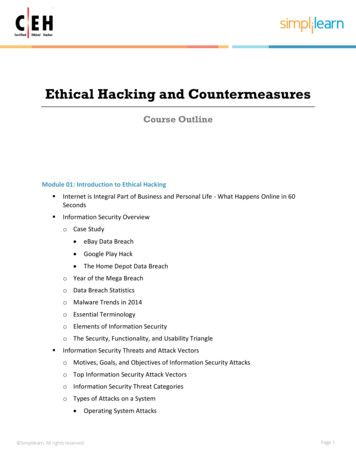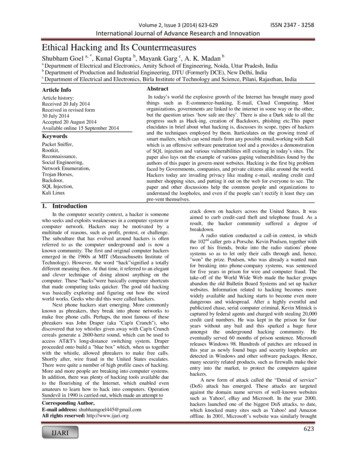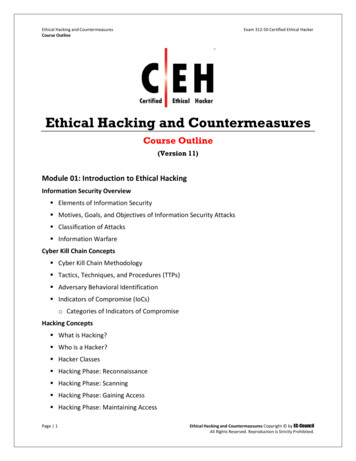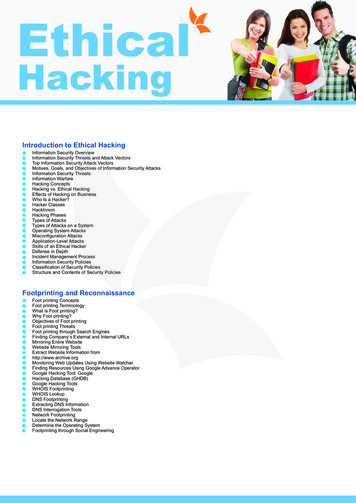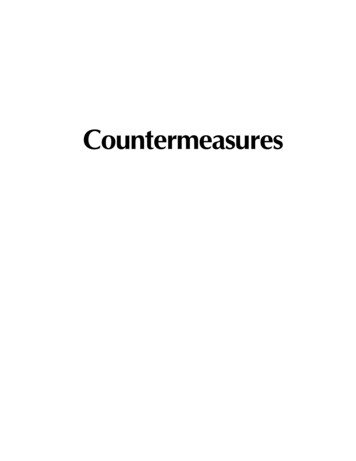
Transcription
Countermeasures
Study group organized by theUnion of Concerned Scientists and theSecurity Studies Program at theMassachusetts Institute of Technology
CountermeasuresA Technical Evaluation of theOperational Effectiveness of the PlannedUS National Missile Defense SystemAndrew M. Sessler (Chair of the Study Group), John M. Cornwall,Bob Dietz, Steve Fetter, Sherman Frankel, Richard L. Garwin, Kurt Gottfried,Lisbeth Gronlund, George N. Lewis, Theodore A. Postol, David C. WrightApril 2000Union of Concerned ScientistsMIT Security Studies Program
2000 Union of Concerned ScientistsAcknowledgmentsAll rights reservedThe authors would like tothank Tom Collina, StuartKiang, Matthew Meselson, andJeremy Broughton for theircomments and assistance. Theauthors owe a special note ofThe Union of Concerned Scientists is a partnership of citizens andscientists working to build a cleaner environment and a safer world. Formore information about UCS’s work on arms control and internationalsecurity, visit the UCS website at www.ucsusa.org.gratitude to Eryn MacDonaldand Anita Spiess for theircontributions and dedication,without which this reportThe Security Studies Program (SSP) is a graduate-level research andeducational program based at the Massachusetts Institute ofTechnology’s Center for International Studies. The program’s primarytask is educating the next generation of scholars and practitioners ininternational security policymaking. SSP supports the research work ofgraduate students, faculty, and fellows, and sponsors seminars, conferences, and publications to bring its teaching and research results to theattention of wider audiences.would not have been possible.This report and its dissemination were funded in part bygrants to the Union of Concerned Scientists from theCarnegie Corporation of NewYork, The John D. andCatherine T. MacArthurFoundation, The John MerckCover illustration: An artist’s rendition of two kill vehicles approachinga cluster of balloon decoys, one of which might enclose a warhead.Fund, The New-Land Foundation, Inc., Ploughshares Fund,and the W. Alton JonesFoundation; and to the MITSecurity Studies Program fromThis report is available online at www.ucsusa.org. To order printedcopies: Email pubs@ucsusa.orgCall 617-547-5552Write toPublications DepartmentUnion of Concerned ScientistsP.O. Box 9105Cambridge, MA 02238-9105Printed on recycled paper.the W. Alton Jones Foundation, The John D. andCatherine T. MacArthurFoundation, the Ford Foundation, and the CarnegieCorporation of New York.
To Henry Kendall, who was part of the studygroup, and whose intellectual contributionsand personal involvement we greatly missedin preparing this report.
vi
Contents in BriefContents in DetailFiguresTablesBoxesExecutive Summary1. Introduction2. The Existing and Emerging Ballistic Missile Threat to the United States3. The Planned NMD System4. Countermeasures to the Planned NMD System:Why the Attacker Has the Advantage5. Countermeasure Programs in the United States, Britain, France, Russia, and China6. An Overview of Emerging Missile State Countermeasures7. Emerging Missile State Countermeasures 1:Submunitions with Biological or Chemical Agents8. Emerging Missile State Countermeasures 2:Anti-Simulation Balloon Decoys for Nuclear Warheads9. Emerging Missile State Countermeasures 3:A Nuclear Warhead with a Cooled Shroud10. Testing the NMD System: Requirements and Recommendations11. Past US Tests Against “Countermeasures”12. The Security Costs of NMD Deployment13. Deterrence and 5AppendicesA. The Thermal Behavior of Objects in SpaceB. The Measurement and Discrimination Capabilities of SBIRS-LowC. The Radar Cross Section of Warheads and Other ObjectsD. The Measurement and Discrimination Capabilitiesof the NMD Ground-Based RadarsE. Countermeasures to Ballistic Missile Defenses:Past and Current Programs in the United States, France, and BritainF. The Reentry Heating of SubmunitionsG. NASA Air Density Explorer Series Inflatable Balloon SatellitesH. The Thermal Effects of a Warhead Inside a BalloonI. Shroud Cooling RequirementsJ. Exoatmospheric Hit-to-Kill Intercept Tests145149159161167169Contributor Biographies173119125131135vii
viii
Contents in DetailFiguresTablesBoxesxivxvixviiExecutive Summaryxix1. IntroductionPurpose of the StudyScope of the StudyCriteria for DeploymentSources and MethodsThe Structure of This Report2. The Existing and Emerging Ballistic Missile Threat to the United StatesAn Accidental, Unauthorized, or Erroneous Launch by RussiaSize of the Future Russian Nuclear ArsenalAn Accidental, Unauthorized, Erroneous, or Deliberate Attack by ChinaThe Threat from Emerging Missile PowersWarheads Available to Emerging Missile PowersConventional WarheadsChemical WarheadsBiological WarheadsNuclear Warheads3. The Planned NMD SystemHow the NMD System Would Evolve over TimeHow the NMD System Is Designed to Operate1123445589101213131516191920Launch DetectionWarhead Detection and TrackingWarhead DiscriminationInterceptor GuidanceKill Vehicle HomingBattle Management2126272828284. Countermeasures to the Planned NMD System:Why the Attacker Has the Advantage31Defense Will Commit FirstDefense Must Work First TimeDefense More Technically Demanding than OffenseStandards of Success for Defense Are High31323232ix
5. Countermeasure Programs in the United States, Britain, France,Russia, and ChinaPast and Current Countermeasure Programs to Ballistic Missile DefensesUnited StatesCountermeasures for ICBMsCountermeasures for SLBMsFranceBritainRussiaChina6. An Overview of Emerging Missile State Countermeasures35353535363636363739Overwhelming the Defense: Submunitions for Biological and Chemical Weapons 41Decoys: Overwhelming the Defense with False Targets41Replica DecoysDecoys Using Signature DiversityDecoys Using Anti-simulationMetallized BalloonsShrouds of Multilayer InsulationChaffElectronic DecoysLate Deployment of DecoysReducing Radar SignaturesPrevent Hit-to-Kill by Infrared StealthLow-Emissivity CoatingsCooled ShroudPrevent Hit-to-Kill Homing by Hiding the WarheadWarhead ManeuversPreemptive Attacks on Defense Components7. Emerging Missile State Countermeasure 1:Submunitions with Biological or Chemical AgentsShould the Baseline Threat Include Chemical and Biological Weapons?SubmunitionsThe Design, Construction, and Use of SubmunitionsDetails of Dispensing BombletsDetails of Heat Shielding of Bomblets During ReentryHeating or Cooling of Bomblets During MidcourseReleasing the Agent8. Emerging Missile State Countermeasure 2:Anti-Simulation Balloon Decoys for Nuclear WarheadsDesign, Construction, and Deployment of BalloonsHow Anti-Simulation Balloon Decoys Would Prevent Midcourse DiscriminationDiscrimination by Infrared SensorsDaytime AttacksThe thermal behavior of empty balloonsThe thermal behavior of a balloon containing a warheadNonuniform balloon 3545557575961636464646567
Nighttime AttacksDecoys Effective for Both Daytime and Nighttime AttacksDiscrimination by Radars: Mechanical Interactions Between Warhead and BalloonDiscrimination and Intercept During Early ReentryMeasures the Attacker Could Take to Prevent DiscriminationDenying High Precision Velocity and Position MeasurementsExploit the Defense GeometryCold-Gas ThrustersSpinning or Oscillating BalloonsTethered Clusters of BalloonsExploit Defense Limitations in Determining the Target Position9. Emerging Missile State Countermeasure 3:A Nuclear Warhead with a Cooled ShroudThe Design DetailsReduced Infrared Detection RangeDetection Using Reflected RadiationReflected Infrared RadiationReflected Visible Light10. Testing the NMD System: Requirements and RecommendationsTesting Military SystemsConfidence Levels and EffectivenessThe Operational Requirements for the Planned NMD SystemDetermining the Single-Shot Kill ProbabilityIndependence of Failure 5Testing and CountermeasuresThe Planned Testing Program for the NMD SystemAn NMD Testing Program to Assess Operational Effectiveness96971001. Ask the right question: Accurately define the baseline threat2. Make it possible to get a valid answer to the question:Provide for the best in countermeasure testing3. Answer the question well: Conduct enough tests4. Make sure the answer is correct: Provide for objective,independent test assessment10011. Past US Tests Against “Countermeasures”The Use of “Decoys” in ERIS TestsMSX ExperimentSensor Fly-by Tests for NMDTests of Ground-based Radar at KwajaleinFirst NMD Intercept TestSecond NMD Intercept TestAn ERINT Test Against 6xi
12. The Security Costs of NMD DeploymentRussiaChinaEmerging Missile StatesOther StatesConclusions13. Deterrence and DiplomacyEmerging Missile StatesExport ControlsCooperationDeterrencePrelaunch DestructionBoost-Phase DefensesRussia and 17117118118118AppendicesA.The Thermal Behavior of Objects in SpaceThe Physics of a BlackbodyThe Physics of a GraybodyThe Physics of Real TargetsEquilibrium Temperatures in SpaceObjects in daylightObjects at nightTime Required to Reach Equilibrium TemperatureB.C.119120120121121123123The Measurement and Discrimination Capabilities of SBIRS-Low125Medium- to Long-Wave Infrared and Long-Wave Infrared Sensors126Sensor ResolutionDetection Range126127Visible Light Sensor128Sensor ResolutionDetection Range128128SBIRS-Low Measurements of Targets in Space128Detection of TargetsTemperature MeasurementsMeasurements of Emissivity-Area ProductOther Measurements128128128129The Radar Cross Section of Warheads and Other ObjectsHigh-Frequency RegimeResonance RegimeLow-Frequency Regimexii119131131132134
D.The Measurement and Discrimination Capabilitiesof the NMD Ground-Based RadarsGeneral DiscussionDetection RangeRadar Cross-Section MeasurementsMeasurement of Angular Location and ResolutionRange Measurement and ResolutionRadial Velocity (Doppler) Measurement and ResolutionImaging Using Doppler MeasurementsThe Measurement and Discrimination Capabilities of the NMD RadarsPAVE PAWS RadarsBMEWS (Ballistic Missile Early Warning System) RadarsUpgraded Early Warning RadarsX-Band RadarsE.Countermeasures to Ballistic Missile Defenses:Past and Current Programs in the United States, France, and BritainUnited StatesCountermeasures for ICBMsCountermeasures for SLBMsFranceBritainF.The Reentry Heating of SubmunitionsHeatshield CalculationsAnalysis for the Spherical BombletAnalysis for the Conical BombletCooling of the Spherical Bomblet During 5145145146147147149150151155157G.NASA Air Density Explorer Series Inflatable Balloon Satellites159H.The Thermal Effects of a Warhead Inside a Balloon161RadiationConduction Through SpacersConduction Through the Gas Used to Inflate the BalloonConvection of the GasEffect of Warhead on Balloon TemperatureHeating Due to the Fissile Material in the Warhead161162162163163164I.Shroud Cooling Requirements167J.Exoatmospheric Hit-to-Kill Intercept Tests169Contributor Biographies173xiii
Figures3-1 View from space of C-1 National Missile Defense system3-2 View from space of C-2 National Missile Defense system3-3 View from space of C-3 National Missile Defense system2223246-1 Photograph of a US replica decoy for the MARK IV reentry vehicle6-2 A schematic drawing of a US Navy electronic reentry decoy43467-1 The configuration used for calculating the heating of a conical bomblet7-2 The trajectory a bomblet would have with no δv after burnout of the missile54548-1 A photograph of one of the NASA Air Density Explorer inflatable balloon satellites8-2 Temperature as a function of time after deployment of lightweight aluminum balloonscoated with varying amounts of white paint8-3 Velocity change due to drag8-4 Position change due to drag8-5 Radar map confusion for three balloons619-1 Schematic diagram of liquid nitrogen cooled shroud9-2 Spinning motion of warhead and shroud will confine liquid-phase nitrogento outer and lower regions of the shroud9-3 Prior to reentry, the shroud could be separated from the warheadusing a spring-loaded device9-4 Relative emission of a blackbody and relative detection rangeas a function of target temperature9-5 Assumed intercept geometry9-6 The region of no reflection for a tipped warhead9-7 Trajectories from North Korea to New York, Chicago, San Francisco, and Hawaiiduring midwinter9-8 Trajectories from North Korea to San Francisco and Hawaii during midspringand midfall9-9 Trajectories from North Korea to Hawaii during midsummer.9-10 Trajectory from Iran to Washington, D.C. during midfall or midspring8284858610-1 Probability distribution for 20 flips and 200 flips9411-1 The target suite for the first two NMD intercept testsxiv66717178838388888989106
A-1 The spectral radiant exitance of two objects as a function of wavelength.A-2 The temperature of four empty balloons with different surfaces (0.5 kg balloons)A-3 The temperature of four empty balloons with different surfaces (3 kg balloons)C-1 Experimental measurements of the radar cross-section of a cone-sphereas a function of aspect (viewing) angle θC-2 Radar cross-section of a sharply pointed cone-sphere as a functionof radar frequencyC-3 RCS in resonance regime as a function of radar frequencyD-1 The radar energy reflected off two identical targetsas a function of the angular position of the center of the radar beamF-1F-2F-3F-4F-5Speed as a function of altitude for the spherical bombletHow the heating equations are applied to the sphereThe local heating rate for the spherical bombletAltitude as a function of time for the spherical bombletThe average heating rate of the spherical bomblet as compared with the stagnationpoint heating rate of the conical bomblet and two reentry vehiclesF-6 The surface-averaged heating rate of the spherical bomblet compared with theheating rate on the wall of the conical bomblet and two reentry vehiclesF-7 Value of the effective heat of ablation used in the calculationsfor refrasil phenolic heatshield materialF-8 Temperature profile in the outer centimeter of heatshield for the spherical bombletF-9 Evolution of the temperature profile in the heatshield of the spherical bombletat times later than F-8F-10 Speed as a function of altitude for the conical bombletF-11 Altitude as a function of time for the conical bombletF-12 Local heating rates for the conical bombletF-13 Temperature profile in the heatshield at the nose of the conical bombletF-14 Temperature profile in the heatshield at a point on the wall of the conical bombletH-1 Temperature variation after deployment of aluminum-coated balloons with andwithout warheadsH-2 Temperature variation after deployment of painted balloons with and withoutwarheads, near room 154154155155156156156156164165xv
Tables2-1 Russian Ballistic Missile-Based Strategic Nuclear Forces, End of 19982-2 Chinese Missile-Based Intercontinental Nuclear Forces693-1 Preliminary Architecture for the C-1, C-2, and C-3 NMD Systems217-1 Stability of common CB agents to heat exposure568-1 Equilibrium temperature, for various coatings, of a sphere in sunlight8-2 The radar horizon for targets at different altitudes64749-1 Lateral kill vehicle acceleration required to hit the target8510-1 Schedule of the NMD Intercept Tests Currently Planned99A-1 The visible absorptivities, infrared emissivities, and their ratio, for several materials122B-1 Peak radiation emitted by objects at different temperaturesB-2 The six different MSX sensor bands125127D-1 Characteristics and Measurement Capabilities of Current and Planned Radars140xvi
BoxesOther Means of Delivery12Delivery of Chemical and Biological Weapons by Ballistic Missile14NMD Components25US Programs for Delivery of Chemical and Biological Weapons52The Velocity and Position Measurement Accuracy of an X-Band Radar75Effectiveness and Confidence Levels: An Illustration94Discrimination104Russian Statements on NMDChinese Statements on NMDAllied Statements on NMD109111114Measurement Accuracy and Resolution137xvii
Executive SummaryThe National Missile Defense system under development by the United States would be ineffectiveagainst even limited ballistic missile attacks from emerging missile states. Moreover, its deployment would increase nuclear dangers from Russia and China, and impede cooperation by thesecountries in international efforts to control the proliferation of long-range ballistic missiles andweapons of mass destruction.The United States should reconsider its options for countering the threats posed by long-rangeballistic missiles and shelve the current NMD plans as unworkable and counterproductive.The United States plans to decide in fall 2000whether to begin deploying a limited national missiledefense (NMD) system. This system is intended to defend US territory from limited attacks by tens of intercontinental-range ballistic missiles armed with nuclear,chemical, or biological weapons. Such attacks couldinclude a deliberate attack by an emerging missile statethat might acquire such missiles in the future; an accidental, unauthorized, or erroneous attack by Russia; oran attack by China.The NMD system would use ground-based interceptor missiles to launch “kill vehicles,” intended todestroy their targets by colliding with them in themidcourse of their trajectory, outside the earth’s atmosphere. The system would track warheads using groundbased radars and satellite-based infrared sensors, andthe kill vehicles would use infrared sensors to home ontheir targets. The planned system would be deployed inphases, with the nominal capability of the system increasing in each phase. If the United States decides thisyear to begin deployment, the initial phase is to be completed by 2005 and the full system by as early as 2010.This report examines in detail whether the plannedNMD system would work against real world missileattacks. It focuses on the effectiveness of the systemagainst the most commonly cited (and presumably theleast sophisticated) threat: attacks by emerging missilestates.While the number of attacking missiles would havea significant impact on the operational effectiveness ofthe NMD system, of greater importance would be the“countermeasures” an attacker took to confuse, overwhelm, or otherwise defeat the defense. The 1999National Intelligence Estimate on the ballistic missilethreat to the United States—a document prepared bythe US intelligence community—stated that countermeasures would be available to emerging missile states.Our study first considers the types of countermeasuresthat a real adversary could use to counter the NMDsystem, and that the system must therefore expect toface. We then make a detailed technical assessment ofthe operational effectiveness of the planned NMD system against a limited attack using three specific countermeasures that would be available to any state able todeploy a long-range ballistic missile.Our analysis of the effectiveness of the NMD system assumes it has all of the sensors and interceptorsplanned for the full system to be deployed only by 2010or later. However, countermeasures could be deployedmore rapidly and would be available to potential attackers before the United States could deploy even themuch less capable first phase of the system.The contributors to the study are all physicists orengineers. Our analysis is based on an understandingof basic physics and technology and uses only information available in the open literature. This detailedanalysis is possible because the United States is nowso close to potential deployment that it has selected thespecific interceptor and sensor technologies that theNMD system would use. We do not believe that accessto classified information would in any significant wayalter our study or its conclusions.The United States must assume that any potentialattacker would conduct a similar, although far moresophisticated, analysis.
Overall Findings and Recommendations:(1) Any country capable of deploying a longrange missile would also be able to deploycountermeasures that would defeat theplanned NMD system.Biological or chemical weapons can be divided intomany small warheads called “submunitions.” Such submunitions, released shortly after boost phase, wouldoverwhelm the planned defense. Moreover, there areno significant technical barriers to their deployment oruse. Because submunitions allow for more effectivedispersal of biological and chemical agents, an attackerwould have a strong incentive to use them even in theabsence of missile defenses. The United States shouldrecognize that any long-range missile attack with biological or chemical agents would almost certainly bedelivered by submunitions, and that the NMD systemcould not defend against such an attack.An attacker using nuclear weapons could also defeat the planned system. An attacker could overwhelmthe system by using “anti-simulation balloon decoys,”that is, by deploying its nuclear weapons inside balloons and releasing numerous empty balloons alongwith them. Or an attacker could cover its nuclear warheads with cooled shrouds, which would prevent thekill vehicles from detecting and therefore from homingon the warhead.Thus, we find that the planned NMD system wouldnot be effective against the limited long-range missilethreats it is intended to defend against—whether fromRussia, China, or emerging missile states. We also conclude that deploying the planned NMD system wouldresult in Russian and Chinese reactions that would decrease US security.Deployment of the planned NMD system would offer the United States very little, if any, protection againstlimited ballistic missile attacks, while increasing therisks from other more likely and more dangerous threatsto US national security.xxCountermeasures(2) The upcoming deployment decision will bemade on the wrong technical criteria.The Pentagon will assess the technical readiness of thesystem prior to the presidential deployment decision.However, this assessment will consider only whetherthe first phase of the system would be effective againsta threat with no credible countermeasures; it will notconsider whether the full system would be effectiveagainst a threat with realistic countermeasures.The United States cannot reasonably exclude theissue of countermeasures from a decision to deploy thefirst phase of the system. A sound understanding of thisissue is needed before a deployment decision is made—even about the first phase. If—as this study finds—even the full NMD system would not be effectiveagainst an attacker using countermeasures, and an attacker could deploy such countermeasures before eventhe first phase of the NMD system was operational, itmakes no sense to begin deployment.(3) A deployment decision should be postponeduntil the system has been tested successfullyagainst realistic countermeasures such asthose described in this report.Tests against realistic countermeasures will not be conducted before the United States makes its planned deployment decision. And it appears that such tests arenot even planned to take place before deployment ofthe initial phase of the system.The United States should recognize that the planneddefense could not counter missiles armed with submunitions filled with biological or chemical weapons, andthus would provide no protection against the threatposed by long-range missiles armed with biological orchemical weapons. For the threat of missiles armed withnuclear warheads, the United States should demonstrate—first by analysis and then in intercept tests—that the planned defense would be effective against realistic countermeasures such as those we examine inthis study: a nuclear warhead deployed with anti-simulation balloon decoys, and a nuclear warhead coveredby a cooled shroud. This should be done before theUnited States makes a commitment to deploy even thefirst phase of the planned NMD system.
Detailed Findings(1) The planned NMD system could be defeatedby technically simple countermeasures. Suchcountermeasures would be available to anyemerging missile state that deploys a longrange ballistic missile.There are numerous tactics that an attacker could useto counter the planned NMD system. None of thesecountermeasures is new; indeed, most of these ideasare as old as ballistic missiles themselves.All countries that have deployed long-range ballistic missiles (Britain, China, France, Russia, and theUnited States) have developed, produced, and in somecases deployed, countermeasures for their missiles.There is no reason to believe that emerging missile stateswould behave differently, especially when US missiledefense development is front-page news.Many highly effective countermeasures require alower level of technology than that required to build along-range ballistic missile (or nuclear weapon). TheUnited States must anticipate that any potentially hostile country developing or acquiring ballistic missileswould have a parallel program to develop or acquirecountermeasures to make those missiles effective in theface of US missile defenses. Countermeasure programscould be concealed from US intelligence much moreeasily than missile programs, and the United Statesshould not assume that a lack of intelligence evidenceis evidence that countermeasure programs do not exist.Many countermeasures are based on basic physical principles and well-understood technologies. As aconsequence, a vast amount of technical informationrelevant to building and deploying countermeasures ispublicly available. Any country capable of building along-range ballistic missile would have the scientificand technical expertise, including people who haveworked on missiles for many years, to exploit the available technologies. Moreover, a great deal of technicalinformation about the planned NMD system and itssensors has been published. A potential attacker couldlearn from a variety of open sources enough about theplanned NMD system to design countermeasures todefeat it.To determine whether technically simple countermeasures would be effective against the planned NMDsystem, we examined three potential countermeasuresin detail: submunitions with biological or chemicalweapons, nuclear warheads with anti-simulation balloondecoys, and nuclear warheads with cooled shrouds. Wefind that any of these would defeat the planned NMDsystem. They would either significantly degrade theeffectiveness of the defense or make it fail completely.Moreover, these countermeasures would defeat theplanned NMD system even if they were anticipated bythe United States. And because these countermeasuresuse readily available materials and straightforward technologies, any emerging missile state could readily construct and employ them.Submunitions with Biological or Chemical Weapons.To deliver biological or chemical weapons by longrange ballistic missile, an attacker could divide the agentfor each missile among a hundred or more small warheads, or submunitions, that would be released shortlyafter boost phase. These submunitions would be toonumerous for a limited defense—such as the plannedNMD system—to even attempt to intercept all of them.Our analysis demonstrates that the attacker couldreadily keep the reentry heating of the submunitionslow enough to protect the agents from excessive heat.Moreover, because submunitions would distribute theagent over a large area and disseminate it at low speeds,they would be a more effective means of delivering biological and chemical agents by ballistic missile thanwould a single large warhead. Thus, an attacker wouldhave a strong incentive to use submunitions, aside fromany concerns about missile defenses.Nuclear Weapons with Anti-simulation Balloon Decoys.Anti-simulation is a powerful tactic in which theattacker disguises the warhead to make it look like adecoy, rather than attempting the more difficult taskof making every decoy closely resemble a specificwarhead.To use this tactic, the attacker could place a nuclearwarhead in a lightweight balloon made of aluminizedmylar and release it along with a large number of similar, but empty balloons. The balloon containing thewarhead could be made indistinguishable from theempty ones to all the defense sensors—including theground-based radars, the satellite-based infrared sensors, and the sensors on the kill vehicle. The defensewould therefore need to shoot at all the balloons to prevent the warhead from getting through, but the attackercould deploy so many balloons that the defense wouldrun out of interceptors.Countermeasuresxxi
Nuclear Weapons with Cooled Shrouds. The attackercould cover a nuclear warhead with a shroud cooled toa low temperature by liquid nitrogen. The cooled shroudwould reduce the infrared radiation emitted by the warhead by a factor of at least one million. This wouldmake it nearly impossible for the kill vehicle’s heatseeking infrared sensors to detect the warhead at a greatenough distance to have time to maneuver to hit it.(2) Many operational and technical factors makethe job of the defense more difficult than thatof the attacker.First, the defense must commit to a specific technology and architecture before the attacker does. This permits the attacker to tailor its countermeasures to thespecific defense system. Second, the job of the defenseis technically much more complex and difficult thanthat of the offense. This is especially true for defensesusing hit-to-kill interceptors, for which there is littlemargin for error. Third, the defense must work the firsttime it is used. Fourth, the requirements on defense effectiveness are very high for a system intended to defend against nuclear and biological weapons—muchhigher than the requirements on offense effectiveness.These inherent offensive advantages would enablean attacker to compensate for
thank Tom Collina, Stuart Kiang, Matthew Meselson, and Jeremy Broughton for their . and the W. Alton Jones Foundation; and to the MIT Security Studies Program from the W. Alton Jones Founda-tion, The John D. and Catherine T. MacArthur Foundation, the Ford Founda-tion, and the Carnegie Corporation of New York. To Henry Kendall, who was part of .
